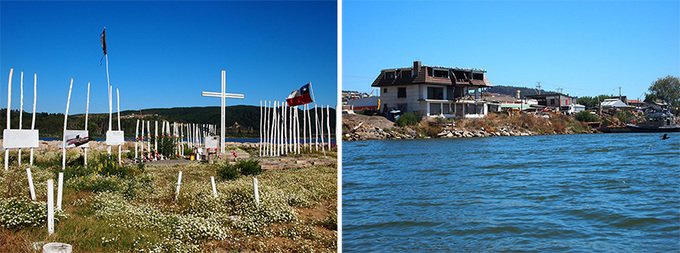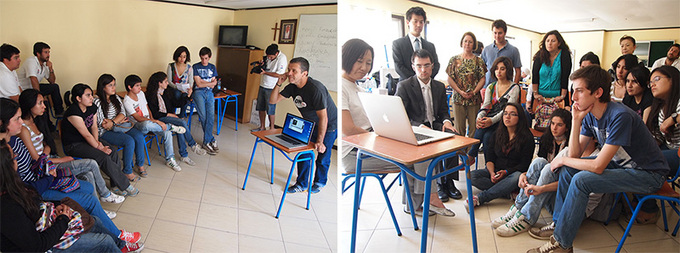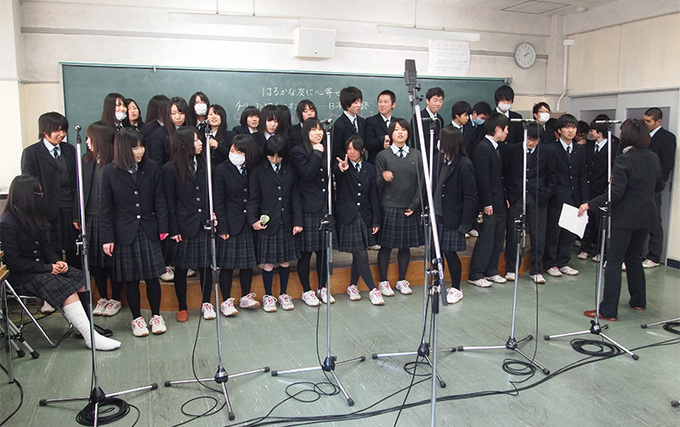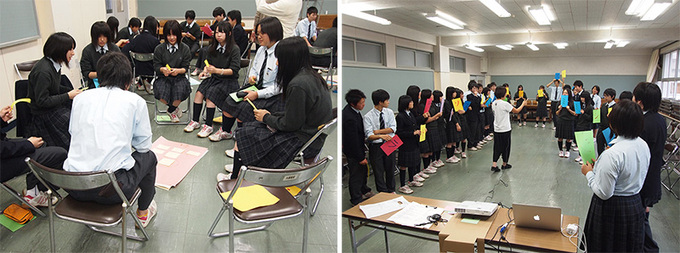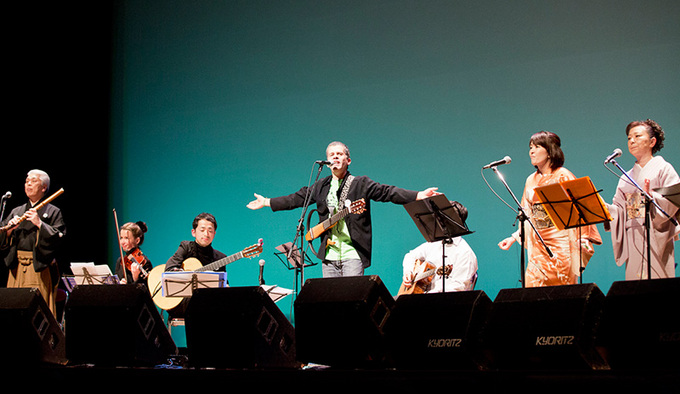Minamisanriku and Chile - Gifts of Poems and Songs that High School Students Exchange with Their Faraway Friends, with All Their Hearts
Keko Yunge
Singer-songwriter, Director of Culture and Sports, "Challenge Rebuild Chile"
The coasts of Constitución in Chile and Minamisanriku in Japan lie 17,000 kilometres away on opposite shores of the Pacific Ocean. Besides this vast expanse of water, they are also separated by very different realities--the millennial history of Japan versus the youthfulness of a country like Chile, topography, population, race, religious beliefs, culture, the level of economic development, living patterns, food, and many other factors.
A call from the Embassy of Japan in Chile
In October 2012, I received a call from the Embassy of Japan in Chile in Santiago, the capital of the country where I live asking me to attend a meeting. The embassy wanted to learn more about "Challenge Rebuild Chile" and the cultural activities that I lead. They also wanted to explore the possibility in co-organizing a cultural project with the Japan Foundation. We had an interesting meeting and some days later I was notified that we had been chosen to be a partner for this joint cultural project.
While a number of differences exist between the two countries, they share common experiences: both were severely affected by the powerful earthquakes and have later achieved reconstructions. In 1960, a tsunami caused by a powerful earthquake in Chile reached the Sanriku coast of Japan and killed 142 people in nearby cities such as Minamisanriku in Miyagi Prefecture and Ofunato in Iwate Prefecture. To promote friendship between the two countries which share similar experiences of recovering from natural disasters, Chile presented a stone replica of a Moai statue to Minamisanriku in 1991, only to be destroyed by the Great East Japan Earthquake in 2011. Chilean President Sebastián Piñera travelled to Japan in March 2012 and promised to donate a new one.
(Editor's note: The new statue, created by Chilean artisans and measuring three meters high and weighing two tons, was exhibited in Osaka and Tokyo and later shipped to Minamisanriku.)
Meanwhile, Chile had been struck by another major earthquake in 2010, killing 525 people. Some 370,000 houses were destroyed throughout the country, including the capital city Santiago. In Constitución, which is located 340 km southwest of Santiago, 104 people died in the tremor that lasted about four minutes and the subsequent tsunami (estimated to be 15m high) that hit the coast.
Based on the Japan Foundation's original idea focusing on these similar experiences between the two countries, the project was first initiated, and we quickly started to exchange ideas on how to develop it. The idea was a worthy one: to visit a school in each city (Constitución and Minamisanriku) with the aim of helping students to express their feelings and thoughts on their experiences after the earthquake and tsunami that occurred in each country, and to exchange them in a literary form. Poem was chosen in Japan and story in Chile. And 38 second-grade students of class 4 of Minamisanriku's Shizugawa High School in Japan and 45 third-grade students of class B of Constitución's Gabriela Mistral School in Chile were selected as the project participants.
Collaboration between a "starfish" and a "butterfly"
I could immediately have a certainty of this project's success. I felt it was both interesting and beautiful at the same time, that these young people from so distant and different places would share their experiences, their visions, thoughts and feelings from what they had lived through. It was also nice to somehow help them understand that they were not the only ones affected by the power of nature, the shocking collapse of their lives, or the deep pain of what they had lost, be it material or otherwise. Also, for "Challenge Rebuild Chile," a very young foundation (only 3 years old), it was an honour to be able to work jointly with the Japan Foundation, an organization having so many years of experience, with so many cultural projects already completed. I also very much liked the Foundation's logo, a butterfly!! How beautiful!! Our logo is a starfish.... I thought that a starfish and a butterfly are magical images. In the meantime, I personally have had a great admiration for the Japanese culture and the way the Japanese do things. Thus we had a lot to learn from them, through this collaborative project.

Logos of "Challenge Rebuild Chile" and the Japan Foundation
Having no budget (at "Challenge Rebuild Chile") to finance the project, I faced an enormous challenge, and so made up my mind to strive to do the best we can, that is, to contribute to realizing something that could really help these young people and everyone else in the two cities that have suffered so much, and also to help leave a message of love in both countries. What I and the Challenge can do would be to provide our time, ideas, positive energy, creativity, network, a song (as a songwriter and singer of popular music), general event production in Chile, and public and media relations that is necessary to promote the project. That's how it all started and everything kept growing....
Forming a team
The first progress update from the Japan Foundation in Tokyo just came in with the names of people we were to work with in the production and musical areas. Kenji Matsumoto would serve as the Japan Foundation's project representative and Masayuki Nishi would be the representative of the Embassy of Japan in Chile. Musicians in charge of creating the composition for the Japanese poem would be Japanese minyo folk music group Hosho-gumi, guitarist Masataka Sato, and producer Yumi Yoshikawa. At the same time, I began to lay the groundwork for the story with the students of Constitución, visiting the school at times to establish contact and motivate them to write about their experiences. Their story would come from a workshop organized by local writer Juan Muñoz. I was also responsible for composing the song that would include the story. The first weeks passed in that way and then the project began to take form: we had worked fast in Chile because students were about to start summer holidays. So the poem comprised of six sections in Japan and the story consisting of seven episodes in Chile were finally completed, and the outcome was amazing indeed....
In spite of the differences between the two countries mentioned earlier, their poem and story expressed similar ideas, and included the same elements of nature used as metaphors and part of the story. They showed the same respect for the ocean, despite the terrible damage it had inflicted. Their feelings of pain, fear, loss, distress, disappointment were the same, and both valued life above all material things. Finally, hope was an extremely important element of their works: They mentioned keywords such as future, rising up, dreaming again, flying, and living!!
We discovered that, in spite of many differences that exist among human beings, we all share the same feelings. I had read this in the writings of the Dalai Lama and it was very exciting to see it true in real life.
Toward the realization of the concert
The following step was decided in November to perform concerts featuring songs that incorporated the poem and story in both cities. The concert dates turned out to be of the tsunami anniversaries, which would make the events even more moving. I soon began taking action to receive as much support as necessary from various areas in order to be able to do something really big. Considering the efforts of the students, the work of the Japan Foundation, the hearts of the people in both cities, the project was worth it. When Matsumoto-san came to Chile on his first visit we travelled through Constitución to visualize several different options for the concert, as well as visited the emblematic places designed to mourn the victims. We had lunch with the city's mayor Carlos Valenzuela, who promised along with the municipality to support us in all that was needed. He wanted the concert to be a welcomed present that would relieve the pain of the city's people.
In Santiago we had a meeting with the cultural corporation of Carabineros de Chile (national police), which quickly decided to join the project and invited us to perform a concert in their spectacular theatre. They also pledged the participation of the national band of Carabineros de Chile. This would deepen the solemnity of the occasion. After Matsumoto-san returned to Japan, along with the Embassy of Japan, we kept working to get it all ready to achieve the best concerts in Chile.
Without realizing it, the time passed, and at the end of February, the Japanese musicians mentioned earlier came to Chile. For this project, I had decided to welcome guitarist Hector "Tito" Pezoa and violinist Laura Bryer, and play with them and the students of Gabriela Mistral School to perform the new musical piece encompassing the students' thoughts. Finally, the Chilean Earthquake Third Anniversary Memorial Concert took place on February 27 at the special stage over the banks of the Maule River in Constitución, and on March 1 at the Teatro del Centro Cultural Carabineros de Chile in Santiago. I would like to say so many things, but at this point I simply stress the ties of friendship that were created among us: the musicians that participated in this project as well as the organizers and leaders. We performed together on stage with the shared wills to collaborate and sing in both languages, and our ego or selfishness was completely left out of the project. And it was really beautiful to see everyone trying to do their best, not only musically but also, and above all, as humanly as possible.
Subsequently, the Japan Foundation invited me and my musicians to play in Japan....
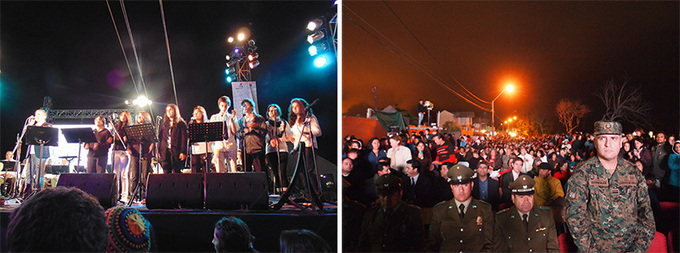
A concert at the special stage over the banks of the Maule River in Constitución

A concert at the Teatro del Centro Cultural Carabineros de Chile
In Minamisanriku, and finally in Tokyo
One thousand experiences in 12 days... But the most exciting part of the trip was having the honour to play in Minamisanriku, at the local fishermen's festival where we played an improvisation, at the Great East Japan Earthquake Second Anniversary Memorial Ceremony on March 11, and on the following day at the Japan-Chile Joint Concert for the locals and the victims of the earthquake. I felt so loved, valued, respected....

A memorial ceremony in Minamisanriku (photo: Kenichi Aikawa)

A joint concert in Minamisanriku (photo: Kenichi Aikawa)
I was warmly received by people I didn't know, with the affection you might show to a relative. This city and the people filled my heart with happiness. I would like to come back as many times as possible to share more with them, and to learn how people can rise again and unite as a community, when everything is stolen away in a matter of second and that breaks your heart. And finally we had a de-briefing session and mini-concert in Tokyo.... I have at home a letter of thanks hanging on the wall, written in Japanese and signed by Minister of Reconstruction of Japan, Takumi Nemoto. Although I don't recognize the characters, I know what it means as I had it translated into Spanish.... Every time I look at it, it reminds me of the warmth of all the people I met: The people I spent some time together at the bays, the hills, and the forests; the fishermen; Kenichi Muraoka who has exerted himself to preserve the local traditional performing arts Gyozanryu Mitobe Shishiodori (deer dance); the family we visited on the first day; the people from the restaurants, the Shizugawa High School, and the hotel we stayed; the mayor of Minamisanriku Jin Sato; the chief priest whose temple served as an evacuation space right after the earthquake; Hosho-gumi and Masataka Sato; Yumi Yoshikawa who kindly arranged our itinerary; Patricia (Kanae Ogawa) who translated everything for me; the people who took pictures and recorded the events; and the wonderful staff at the Japan Foundation, working every day to achieve a better world... And then I get emotional and miss them very much!

A de-briefing session and mini-concert in Tokyo (photo: Kenichi Aikawa)
The future that begins with a new friendship
The smallest details can have a chain reaction effect, especially when things are done with passion, love, and service for others in order that they might have better conditions in their lives.... And this project proved it!! We performed five concerts, two in Chile and three in Japan. We had national and international attention, important press coverage, television broadcasting, the attendance of authorities, and new friendship and cooperation ties developed among institutions like the Japan Foundation, "Challenge Rebuild Chile," the Embassy of Japan in Chile, the cultural corporation of Carabineros de Chile, the national national band of Carabineros de Chile, the illustrious municipality of Constitución, the Embassy of Chile in Japan; and above all, we encouraged young people to express and share their experiences and helped those who have suffered so much pain to open their hearts once again. After the concert in Constitución, a woman wrote the following on my Facebook page: "I feel really grateful for such an exciting ceremony to commemorate the Maule region brothers who are no longer with us but will always be in our hearts. Thank you! The soul hurts less when singing."
Dear great new friends, Matsumoto-san and Nishi-san.... We made it... all together... with everybody.... We could move the world a little bit. Thanks for this wonderful opportunity!!
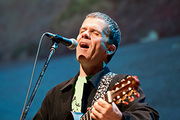 Keko Yunge
Keko Yunge
Born in 1962 in Santiago, Chile. Keko Yunge is known as a singer-songwriter. Since his debut in 1984, he has been known nationwide as a popular singer, releasing a number of hit songs. He has released nine CD albums so far and his Best Album containing his hit songs from the last twenty years was a platinum disc. In addition, Yunge has played in several foreign countries such as Canada, Ecuador, Peru, Argentina, Spain, and Uruguay. Right after the Chile Earthquake on February 27, 2010, he started to work for society through music on a full scale, releasing "Arriba los sueños," a song dedicated to Chile and the people in the disaster area. As the director of Culture and Sports of NPO "Challenge Rebuild Chile (Desafío Levantemos Chile)," Yunge is involved in support projects for the disaster area such as Do Re Mi Project, which aimed to popularize music education, offering musical instruments to the disaster and poverty areas. He also worked in a concert titled "Blue Planet. If you live, I live," which was arranged to raise the awareness of people for environmental protection (www.planetaazul.cl). For the project with the Japan Foundation, Yunge composed a song from the story written by the students of the third grade of class B of Gabriela Mistral School in Constitución, the area affected by the Chile Earthquake. Also, he conveyed the message from the students of Gabriela Mistral School enclosed in the song to Minamisanriku.
http://www.ky.cl/
Keywords
- Traditional Arts
- Literature
- Music
- Social Securities/Social Welfare
- Natural Environment
- Cultural Diversity
- Japan
- Chile
- Challenge Rebuild Chile
- Minamisanriku
- Constitución
- Santiago
- Great East Japan Earthquake
- Ofunato
- Easter Island
- Shizugawa High School
- Hosho-gumi
- Masataka Sato
- Yumi Yoshikawa
- Dalai Lama
- Gyozanryu Mitobe Shishiodori
- Kenichi Muraoka
Back Issues
- 2019.8. 6 Unraveling the Maker…
- 2018.8.30 Japanese Photography…
- 2017.6.19 Speaking of Soseki 1…
- 2017.4.12 Singing the Twilight…
- 2016.11. 1 Poetry? In Postwar J…
- 2016.7.29 The New Generation o…
- 2016.4.14 Pondering "Revitaliz…
- 2016.1.25 The Style of East As…
- 2015.9.30 Anime as (Particular…
- 2015.9. 1 The Return of a Chin…


